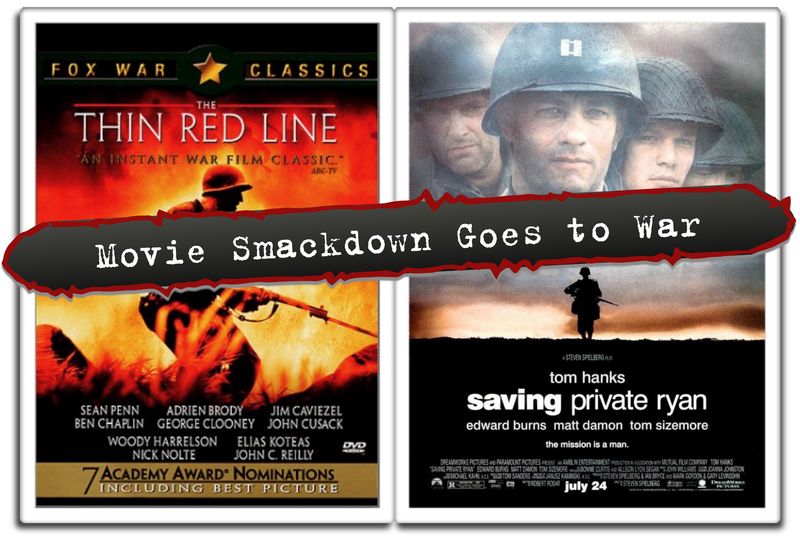
The Smackdown
War is hell. And until Steven Spielberg got involved, we’d never really experienced war through the eyes of a soldier. We’d come close, with filmmakers as diverse as Coppola and Oliver Stone all giving us their interpretations, but it always seemed to be at a safe distance. The viewer was taken on a journey, but not our own journey.Unlike Ron Kovic or Ben Willard, who undertake a journey for us, Spielberg attempted to give us our own experience in war without having to leave the cinema.
At the same time, at a different film studio, a reclusive film director had also embarked upon a journey to show us the inhumanity and insanity of war. Terrence Malick, who disappeared from the Hollywood radar for the better part of two decades in a self-imposed exile, returned with a lengthy, languid exploration of the mental anguish of fighting the war in the Pacific, the other major theater of World War II. Gathering some of the cream of Hollywood talent and star wattage, Malick constructed a story of broken hearts, hope and devastation, with the jungles of the Pacific cast as a beautiful backdrop to some of mankind’s darkest moments.
Spielberg’s Saving Private Ryan goes head-to-head against Malick’s The Thin Red Line. Two mighty juggernauts of cinema. Both set during WWII, both featuring a large cast of known names, all vying for screen-time, all with a story to tell. This Smackdown will be a brutal, casualty-ridden affair that will leave only the bravest, the strongest standing. Soldiers, open fire!
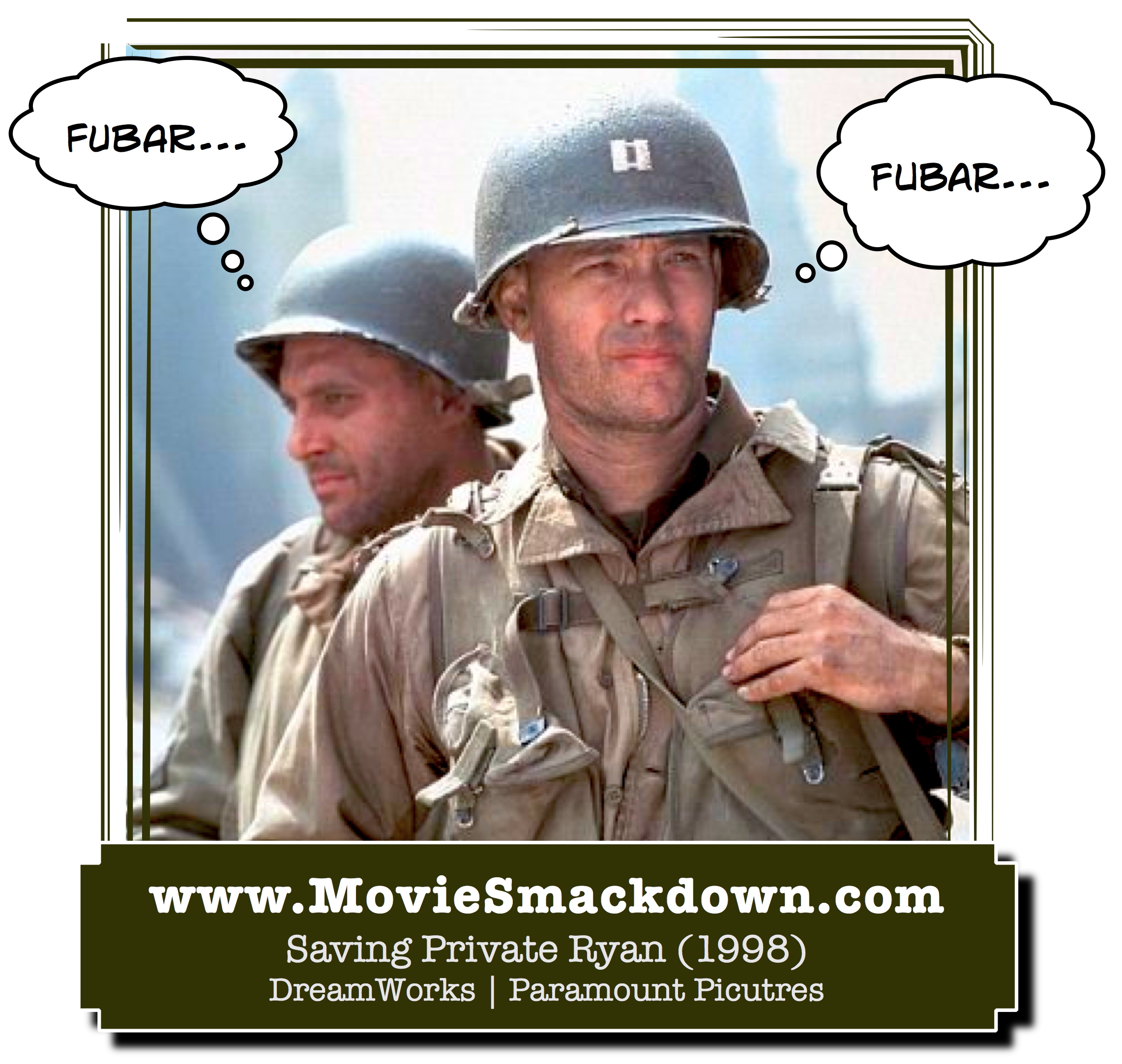
Saving Private Ryan
Saving Private Ryan, which graphically shows us the D-Day landings of a group of US forces in 1944, opens with an assault on the senses unlike any we’d ever seen. It thrust us into the heat of battle, the confusion and carnage of an assault that beggars description. It wanted us to know exactly what war is really like.
The opening to Saving Private Ryan is a tour de force of film making that actually attempts to put the viewer into the middle of the D-Day landings on the beaches of Normandy. Bloody, dirty and as realistic a sequence as had ever been committed to film, suddenly we look at war in a whole new way. A collective shift in our perception of war occurs in that single, brutal 20-minute opening salvo. And a devastatingly heroic band of soldiers attempting to land safely on a beach becomes one of the most harrowing cinematic moments of 1998.
Director Steven Spielberg’s now celebrated anti-war film almost singlehandedly revolutionized the style and look of every single war film that followed, from the horror of Black Hawk Down to the carnage and desolation of Band of Brothers. Finally, the brutality of pure warfare — sans macho bravado and cliched jut-jawed pontification — is revealed. And to those of us inexperienced in it, it was truly awful.
Saving Private Ryan, once the opening sequence comes to a close, moves into more traditional territory when a surviving group of soldiers, led by a stoic Tom Hanks, are sent on a mission to find a missing soldier somewhere in occupied France, so he can be sent home. The private, Ryan, is unaware his three brothers have been killed in action and the powers-that-be have decided that their mother should not be left without any offspring. Thus the politically charged mission to rescue the wayward soldier. Within this story, we are introduced to the characters of the platoon charged with this duty, and come to understand the bravery and primal friendships they strike up as they maneuver through enemy lines.
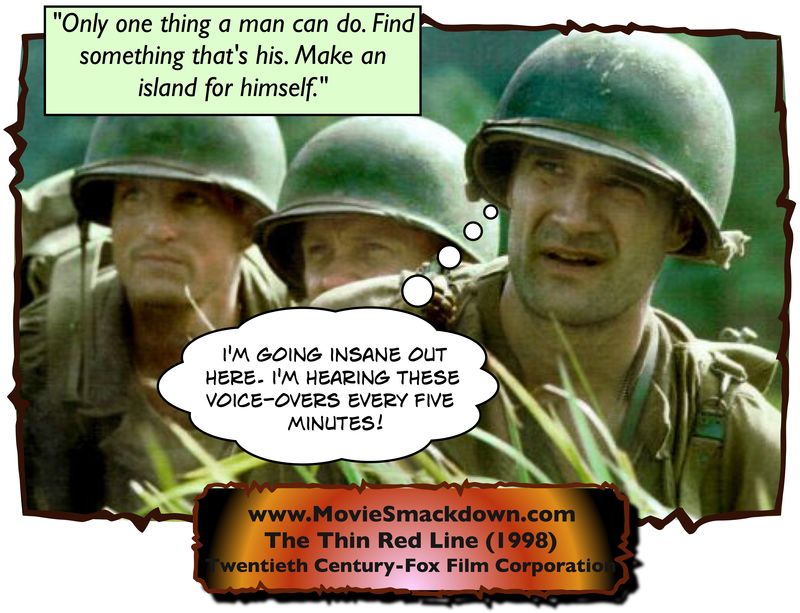
The Thin Red Line
With The Thin Red Line, Sean Penn and James Caviezel lead a massively talented cast into battle, told in a style that is so completely different to Spielberg’s more grimy effort, so ensuring that we experience both styles of film making to endure the horrors of war.
The Thin Red Line straddles the difficult balance between the solitary soldier battling his own inner-demons and fears, and the epic scope of a battleground so impossible to navigate. At its heart is the unimaginable horror of feeling so alone in a place of tranquility and beauty. And the mental hurdles the military machine must face when fighting an enemy on his own territory.
As the battle for Guadalcanal heats up, we are exposed to various storylines from different perspectives, the commanding officer right down to the lowest rank grunt. Everybody gets a moment in this film for a little self-examination, and it’s here where The Thin Red Line achieves some of its success.
The Scorecard
And so we come to it. The decisive battle between a film essaying America’s full-powered entrance into the War in Europe, and one in which we see the mental anguish of continued war in the Pacific. Both films are an indictment on the futility and stupidity of war, and both show the way in which battle strips away the humanity from each person.
In Saving Private Ryan, the bombast and explosive opening stanza soon gives way to a more developed character story, with the complex multi-racial group of soldiers giving lessons in army life to newcomer Private Upham (Jeremy Davies). Upham is seconded as a replacement member of Captain Miller’s depleted company.
Miller (Hanks) doesn’t question the reasons behind what he sees as a futile mission to locate Ryan. Although, the resignation that he is unable to always see the background of a given situation is writ large on his face. Miller leads his men through the French countryside on their mission, which develops some tacit aggression from his men who can’t understand why they are risking the lives of many to save one. A fair question, reasons Miller, but he’s an army man and follows his orders — no matter how stupid or unreasonable they may seem.
With The Thin Red Line, we see a different take on war’s futility. It examines the emotional cost the soldiers fighting these battles endure, as their humanity is slowly stripped away with each kill and battle. The primary character is Private Witt, played by James Caviezel, although he appears and disappears throughout the film’s narrative for the duration.
The film suffers a lot from obvious post-production tinkering, and it’s to the detriment of the film. According to reports, Malick had a lot of issues with the post-production on this film, tinkering with the structure (even trying to remove all the scenes with dialog). He also has final cut on the film, something to which he’s entitled, but perhaps he should have listened to those who had concerns.
Spielberg is a master storyteller, as almost everybody in the world will attest to. Some of his films have fared better than others, but it’s an undeniable fact that the man knows how to pull an audience along with him for the ride.
We’re so desensitized now by the fact that every time a battle sequence is filmed these days, most directors will emulate Spielberg and cinematographer Janusz Kaminski’s style. The super-crisp, jagged technique employed by Kaminski here is a defining moment in cinema. Since then, any time you have a battle, you have to film it like they did in Saving Private Ryan. Spielberg also amped up the tension by de-saturating the film stock of most of its color, perhaps in a similar vein to shooting in black and white like he did on Schindler’s List. Others have come and gone trying to get their films to look as frenetic and stylish. But the fact remains that Spielberg did it first, and revolutionized the way we see battles unfold on screen.
The Thin Red Line, meanwhile, takes its visuals from a more sumptuous style: the wide-screen film format perfectly encompasses the look that Malick was going for in his exploration of the beauty of Guadalcanal. The film is visually impressive. Cinematographer John Toll’s brilliant hues and textures leap off the screen in what is essentially a three-hour postcard of tropical islands. And the expected battle sequences, scattered primarily in the center of this epic film, are beautifully rendered.
The Decision
Private Ryan is one of those films that grabs you by the throat, tosses you around like a dog with a child’s toy, and tries to swallow you without chewing. It’s a visceral, confronting film at times, although at its quietest, it still skirts the depth of emotion and character that would have made this a truly awesome cinematic experience. The film has a number of cast members, all vying for their character to develop on-screen beyond the cliche. Hanks, as the leader, gets the lion’s share of development. And it’s primarily through him that we journey on this film. Unlike The Thin Red Line, which appears not to have any true lead character, since the film sways between so many all the time.
While Saving Private Ryan might be the more cohesive, the more structured narrative of the two films, it’s not without fault. In its quiet moments, the film manages to misstep in its core emotional weight. This is not a fault with anybody in particular, per se, I just think that Ryan’s weighty action sequences and graphic, in-your-face violence tend to tip the balance against the slightly shallow, less-well-rounded characters. The general jabber of the soldiers as they make their way through the countryside is amusing, and their peril unbelievably great. However, we don’t quite get the emotional connection with them all that I would have liked.
As Miller, Hanks delivers yet another performance that should have been a contender for the Best Actor Oscar. He’s aided in his acting duties by a fairly decent cast, including Barry Pepper, Vin Diesel, Tom Sizemore, Edward Burns, Matt Damon, Adam Goldberg and Giovanni Ribisi. But we don’t really understand their motivations. We don’t get into their heads like we want to. The script tends to focus more on the mission statement and the action, leaving us only the merest moments to pause between battles. It’s a little frustrating, but not enough to lessen your enjoyment of the film.
The bloated, unfocused The Thin Red Line, to be honest, is a chore to get through. Clocking in at a bladder-bursting three hours, the film needed to have a coherent structure and narrative in order to maintain interest. Since Malick seems determined to confuse the audience with a multitude of characters with the merest transient moments (Check out George Clooney’s ten-second cameo at the end. How does he get major marquee billing out of that?) and a desire to focus on the ethereal, the ephemeral, rather than the realistic, this film becomes a lumbering, badly paced triumph in cinematic flatulence. This is the kind of arrogant film making you’d label as being made by an auteur. Malick’s inability to generate any tension or emotive weight until about 90 minutes into the film is indicative of just how much you’ll enjoy this test of endurance.
The film really takes off during it’s brilliant middle act: the storming of a hillside by a platoon of soldiers, and Nick Nolte’s gruff, brutal commanding officer, Colonel Tall, are glimpses of sublime film making. Here the tension ratchets up, as Tall must try and convince Captain Staros (Elias Koteas, in one of his finest film performances) to lead his men up the hill in what appears to be a suicide mission. At this moment, The Thin Red Line becomes a great war film.
Then, that goodwill evaporates the moment we head into the convoluted, incoherent and stubbornly inane final act, where Malick again demonstrates his pomposity to his audience by drifting into this weirdly lame, wishy-washy dialog intercut with images meant to be poignant and meaningful: they aren’t… and it isn’t. Not even the great Sean Penn can carry this films final act into anything even remotely resembling good storytelling. What story? Where’s the story going? You’re screaming at the screen for the movie to hurry the hell up and do something! It’s all pointless. As an audience we don’t have anybody we can really root for the whole way through, which is a crucial mistake to make. A film without a key character whose journey we follow, is a film devoid of interest.
And why does Malick seem intent on shooting long takes of trees, flowers and foliage, all of which merely serve to pad out an otherwise bloated film? Many viewers got sick watching yet another long tracking shot of enormous trees stretching up into the sky, of flowers and jungle-scapes that last for ages but generate no emotional response from the audience. .
Let’s get this straight: you can spend a long time trying to dissect The Thin Red Line to try and figure out what on Earth it’s point is. There are copious voice-overs, from almost every character on screen thinking about war and the futility of it all. To be honest, it often plays like hippie hocus pocus to me. And I detested the arrogance of Malick to think he could make a film like this and expect people to appreciate the “art” of it all. We get the same emotion from postmodern art and monkey paintings.
Saving Private Ryan was a landmark film in many ways, mainly for the way in which it revolutionized the war picture genre and gave it a genuine shot of adrenaline going forward. The ante had been upped, and again it had been Spielberg at the forefront.
Oh how we wish Terrence Malick had stayed off the directorial radar. The Thin Red Line is a tedious, vacant cinematic experience, perhaps best reserved for waking people from a coma by being even more boring than being in a coma. Spielberg’s film is a vastly superior cinematic experience, a real war film that allows us to experience what it must be like for combat troops.
While The Thin Red Line had only the barest of great moments, Saving Private Ryan is filled with them. In this titanic battle of war, go looking for Private Ryan, and skip past the thin red line.

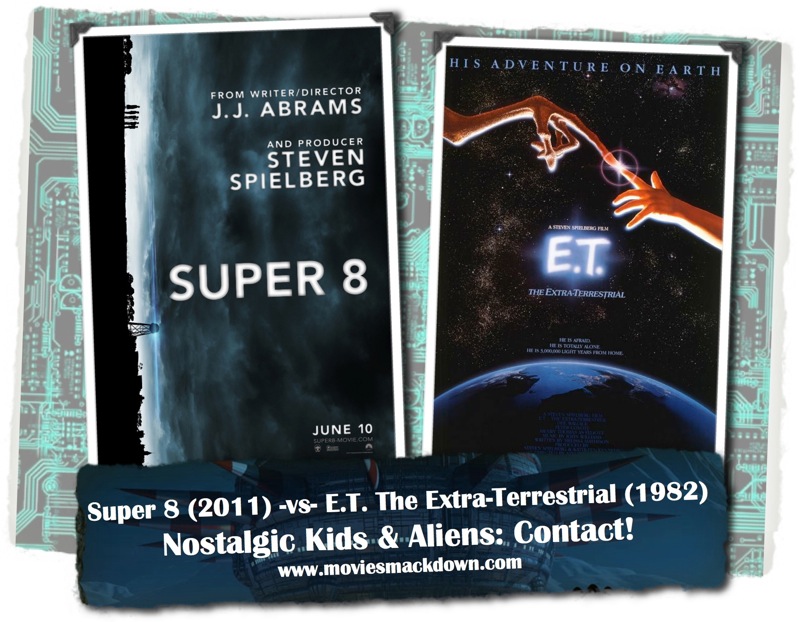
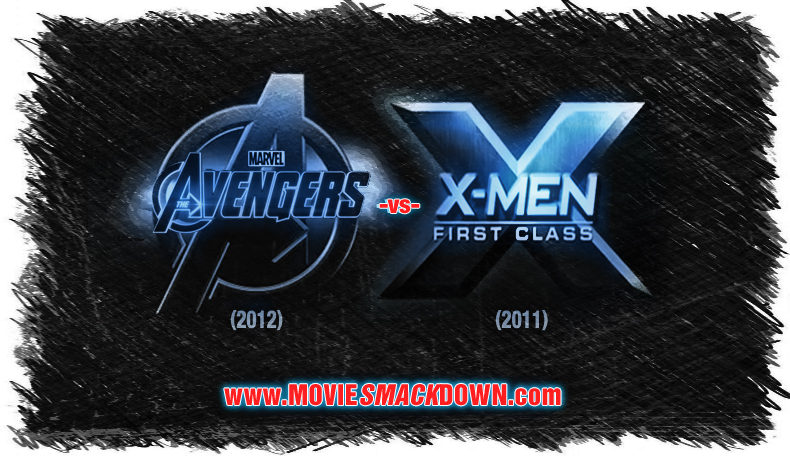
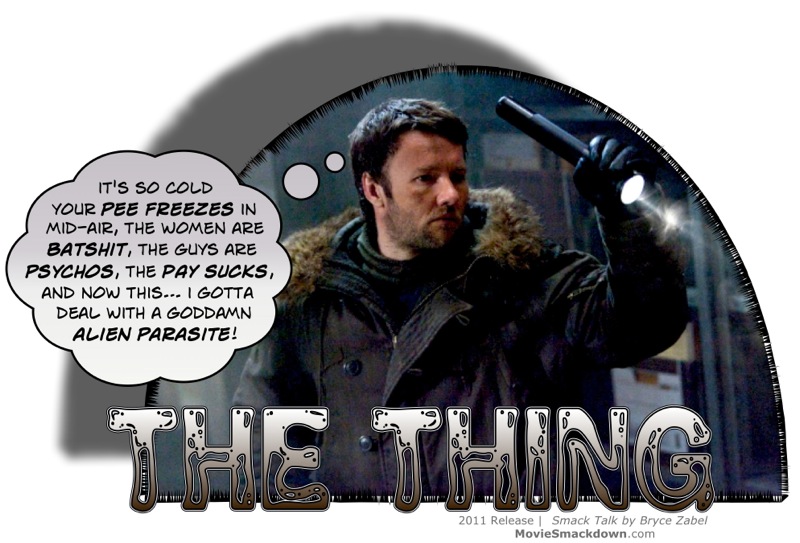
I’m with Rodney on this. BADLANDS and DAYS OF HEAVEN are seminal films that still move and inspire me. Heck, I loved TREE OF LIFE and its daring use of film technique to tell an internal story together with a cosmic one. THIN RED LINE, however, a lone battleship lumbering around the South Pacific in search of enlightenment. PRIVATE RYAN has its problems, notably the entire section with Ryan’s company before the final battle, Hanks’ hokey “Earn this” line, and the horrendous framing device of the contemporary Ryan at Normandie with his family. However, PRIVATE RYAN gets war right: carnage, heroism, carnage, cowardice, terror, carnage, boredom and above all, carnage, that makes most of it impossible to sit through and equally impossible to turn away. Not unlike APOCALYPSE NOW – the other imperfect masterpiece that gets war right.
Saving Private Ryan is brilliant on many levels, and gut-wrenchingly powerful. But The Thin Red Line is deeply spiritual – as are all of Malick’s movies – and it took me places Spielberg couldn’t reach in Saving Private Ryan.
A Smackdown between these two movies is like a bout between Tyson and Gandhi: one is all about packing a hard punch, while the other is more interested in what motivates people to punch each other in the first place. So, I guess, in the context of this analogy, The Thin Red Line would get its ass kicked! But between Gandhi and Tyson, I know who I’d rather spend time with.
Love this comment, Robbie. I hope you’ll write more for us.
Thanks, Eric!
The Thin Red Line is about how war turns “men into dogs” and how war is “all about property”.
ITS NOT ABOUT HAVING THE MOST ACTION SCENES
Listen to the soundtrack alone!
Your telling me the scene where there mowing down people in a japanese field hospital is boreing?
That scene is not suppose to be exiting, it’s not about action!
“SAVING PRIVATE RYAN” is not an anti-war movie. It pretends to be one, but it’s not.
You like Saving Private Ryan more because it’s EASY. It’s a simple film with a simple (though counter-intuitive) message for simple audiences.
I am commenting a little late here, but I just saw this smackdown and had to comment! Hahaha.
The Thin Red Line is hands down the better film, as well as Malick being far and above the superior director. Saving Private Ryan is a very good movie and Spielberg is a good, albeit extremely overrated, director; but TTRL is easily the more profound of the two films. When you finish watching SPR you say to yourself, “Wow, that was cool!” and then you forget it. When you finish watching TTRL you are left with deep emotional and psychological effects. To me TTRL wins by a landslide!
Sarcasm noted. TTRL isn’t subtle. It’s art-house pretension of the highest order. I like character development as much as anybody else, I just don’t get that out of Malick’s movie. All I get is a sore bum waiting for something…. anything… to happen.
Thanks for the sarcasm though, I needed some of that! 😉
Totally AGREEE!!! When I see a war film, i like to see people get shot! None of that stupid character development crap cause that’s sooo boring, LOL!
Maybe in war, people do have profound thoughts that could be illustrated with voice-overs, and maybe looking at nature which has existed long before us would cause us to question why war has a place in this world–maybe soldiers had thoughts like that…
Whatever!! I’m like my friend Roddy here! War films are for shooting people, and I don’t want to have to think too much. I want to carried through a typical hollywood narrative, even though true war experiences aren’t structured to make sense. I want to watch good guys fighting bad guys, and eventually take on a super villain! (SPR’s got one!) I don’t want to see how the other side has humanity too…. BORING!
Rodney I know you weren’t smart enough to pick up on the subtleties of TRL, but I hope you can pick up on my sarcasm! Toodles.
Sure Karl, I have heard of it, and (a while ago) seen it. I guess I should have been more specific in my opening statement: perhaps I should have intimated that perhaps we’d never seen the blood and fury of battle through the eyes of a soldier, quite like this.
War is hell. And until Steven Spielberg got involved, we’d never really experienced war through the eyes of a soldier.
All Quiet on the Western Front was released in 1930. It won an Academy Award for Best Picture. Being a critic, surely you’ve watched it, or, at the very least, heard of it?
But those FX support the film, they don’t denigrate it’s value! They’re FX that help tell the story, not remove the viewer from the film experience a la the Star Wars Prequels……
Thin Red Line will stand the test of time okay, but for different reasons. As far as impact goes, SPR remains the better film.
THIN RED LINE will stand test of time, SAVING PRIVATE RYAN was good but efx heavy.
I have to say Saving Private Ryan on this one. It is such a long movie but it is great in every aspect of it! http://www.mymoviedownloadz.com
People who know me know I love to expose myself.;) Thanks for the positive feedback Warmachine, and consider it done!!
Great to see you getting exposed to a larger audience on Movie Smackdown, Rodney. Hope to see many more!
While I aquiesce to the amazing talent that Scorcese brings to the table, and whose opinion I hold to be one of the great cinematic commentators in the word today (I could listen to him talk about film for hours!), I have to humbly say that in that instance, I think he’s wrong.
Phenomenally comprehensive analysis, Rodney. I have loved SAVING PRIVATE RYAN from the day I saw it and have now seen it probably six times. It clearly distinguishes itself by having the stronger narrative. Oddly, I think in contrast to your POV, was THE THIN RED LINE supposedly promoted by its director as a more true war film, that showed how the experience is multi-faceted and changing. Kind of like long periods of boredom interspersed with moments of sheer terror. Anyway, I agree with the call, although there were moments I liked a lot in TRL, but not enough and too many of the wrong kind. Scorcese, I think, thought it was the 2nd best film of the 90s, so go figure.